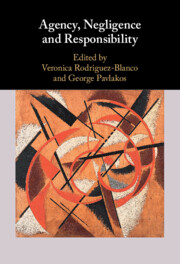Book contents
- Agency, Negligence and Responsibility
- Agency, Negligence and Responsibility
- Copyright page
- Dedication
- Contents
- Figures
- Contributors
- Acknowledgements
- Introduction
- Part I Will and Blameworthiness
- Chapter 1 The Problem of Pure Negligence
- Chapter 2 Unwitting Omissions, Mistakes and Responsibility
- Chapter 3 “How Could You?”
- Chapter 4 Varieties of Negligence and Complications for Moral Blameworthiness
- Part II Agency, Reasons and Inadvertence
- Part III The Significance of Action in Negligence
- Bibliography
- Index
Chapter 1 - The Problem of Pure Negligence
from Part I - Will and Blameworthiness
Published online by Cambridge University Press: 28 October 2021
- Agency, Negligence and Responsibility
- Agency, Negligence and Responsibility
- Copyright page
- Dedication
- Contents
- Figures
- Contributors
- Acknowledgements
- Introduction
- Part I Will and Blameworthiness
- Chapter 1 The Problem of Pure Negligence
- Chapter 2 Unwitting Omissions, Mistakes and Responsibility
- Chapter 3 “How Could You?”
- Chapter 4 Varieties of Negligence and Complications for Moral Blameworthiness
- Part II Agency, Reasons and Inadvertence
- Part III The Significance of Action in Negligence
- Bibliography
- Index
Summary
In the case of negligent action, it is less clear what it means to manifest ill will, since the agent’s conscious choices may assign the appropriate weight to reasons. The relevant notion of expression is a causal notion: your negligent act expresses an insufficiently good will when (a) you have an insufficiently good will and (b) this fact plays some causal role in your conduct. The challenge is to characterize the relevant causal role. The easy case is the case in which the current negligent act is the foreseeable upshot of prior culpable wrongdoing. The hard case is the case in which there is no such prior act. The chapter describes a number of such cases, focusing mainly on negligent actions done from “implicit bias” and other non-conscious motives. The main claim is that conduct of this sort does manifest "ill will": for the purposes of understanding the “quality of will” condition, (almost) any causal relation between ill will and act will do. If it is unclear whether such conduct is culpable, this is not to be explained by appeal to the quality of will condition, but rather by reference to another condition on moral blameworthiness, which the paper seeks to articulate.
Keywords
- Type
- Chapter
- Information
- Agency, Negligence and Responsibility , pp. 15 - 36Publisher: Cambridge University PressPrint publication year: 2021
- 1
- Cited by

